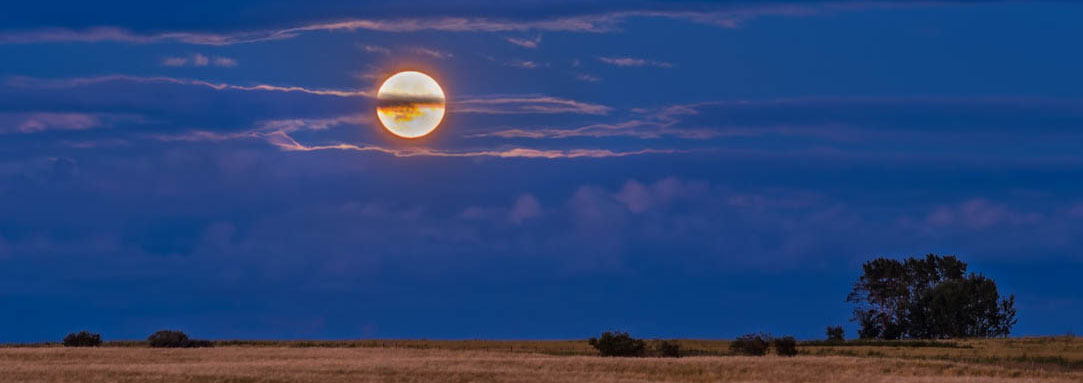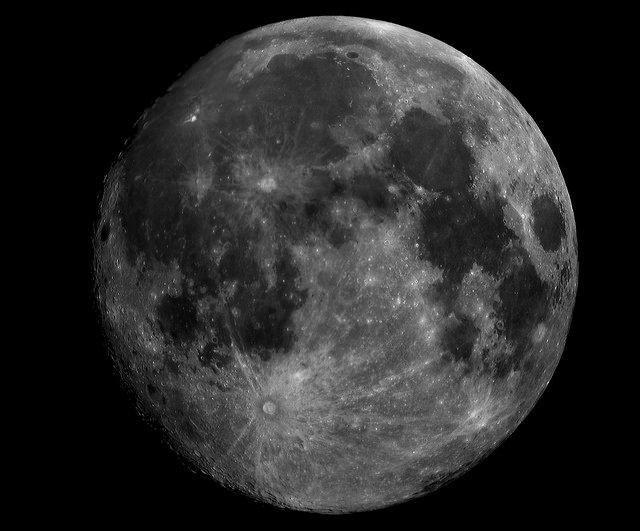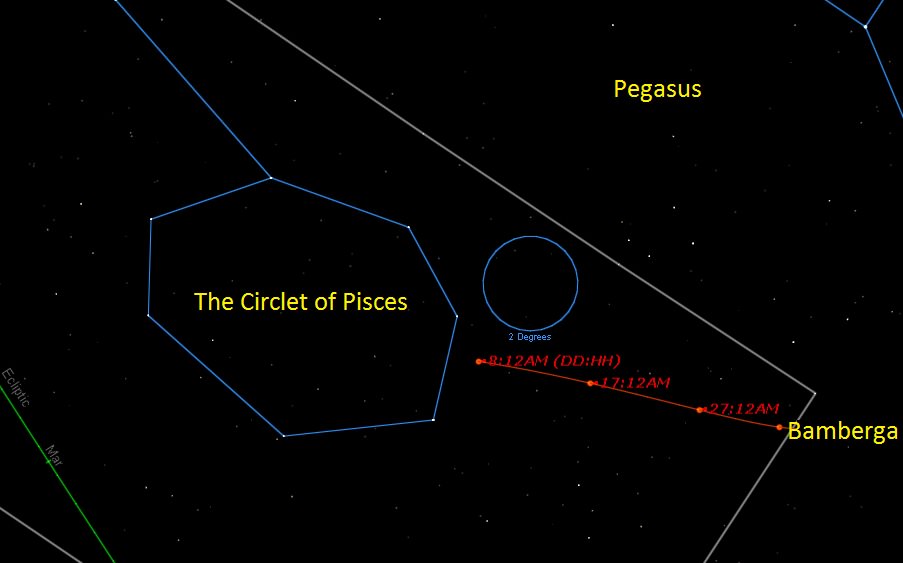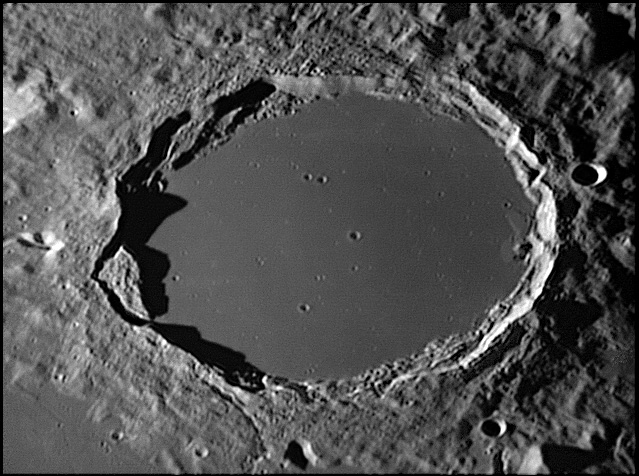Following the Moon lately? The up and coming Full Moon is the most famous of them all, as we approach the Harvest Moon for 2018. Continue reading “Heralding the 2018 Harvest Moon”
The Lowdown on September’s Harvest Moon

It’s that wonderful time of year again when the Harvest Moon teeters on the horizon at sunset. You can watch the big orange globe rise on Friday (Sept. 16) from your home or favorite open vista just as soon as the Sun goes down. Despite being one of the most common sky events, a Full Moon rise still touches our hearts and minds every time. No matter how long I live, there will never be enough of them.
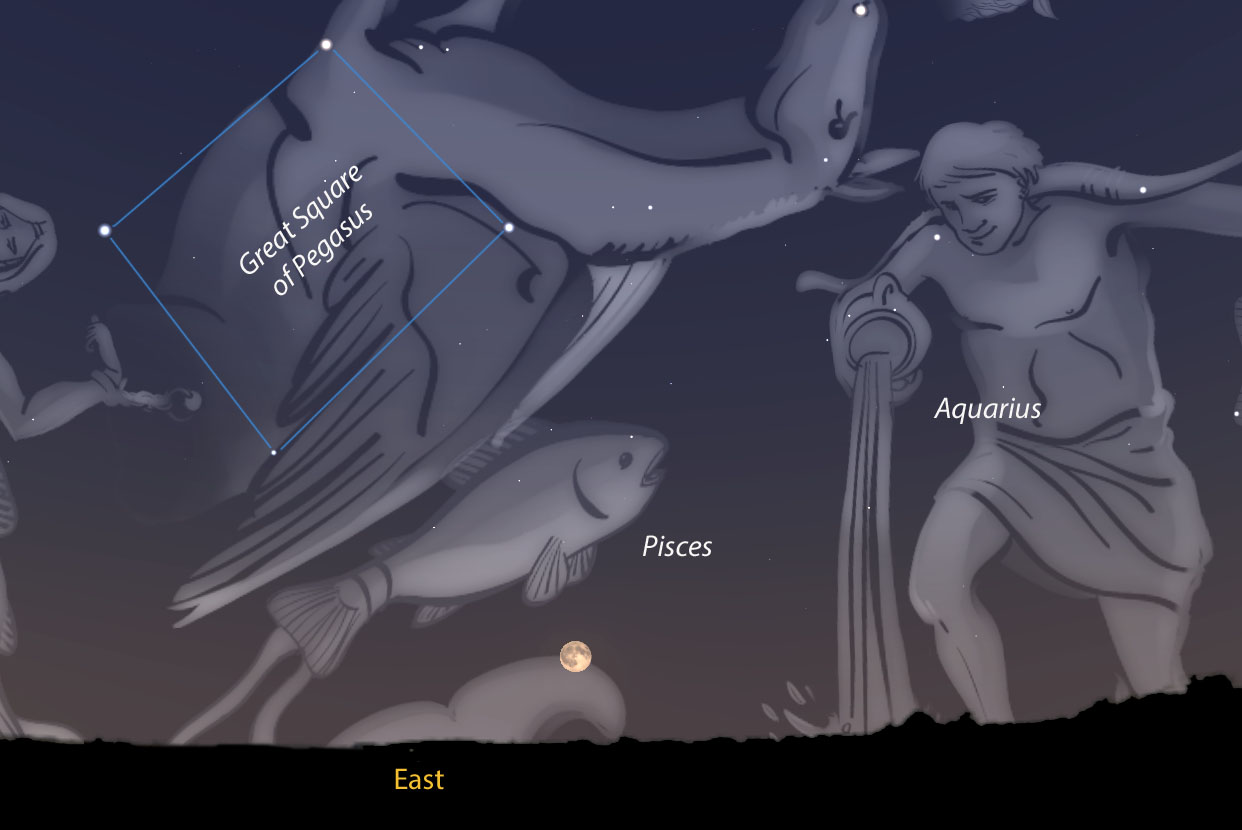
To see a moonrise, the most important information you need is the time the moon pops up for your city, which you’ll find by using this Moonrise and Moonset calculator. Once you know when our neighborly night light rises, pre-arrange a spot you can walk or drive to 10-15 minutes beforehand. The waiting is fun. Who will see it first? I’ll often expect to see the Moon at a certain point along the horizon then be surprised it’s over there.
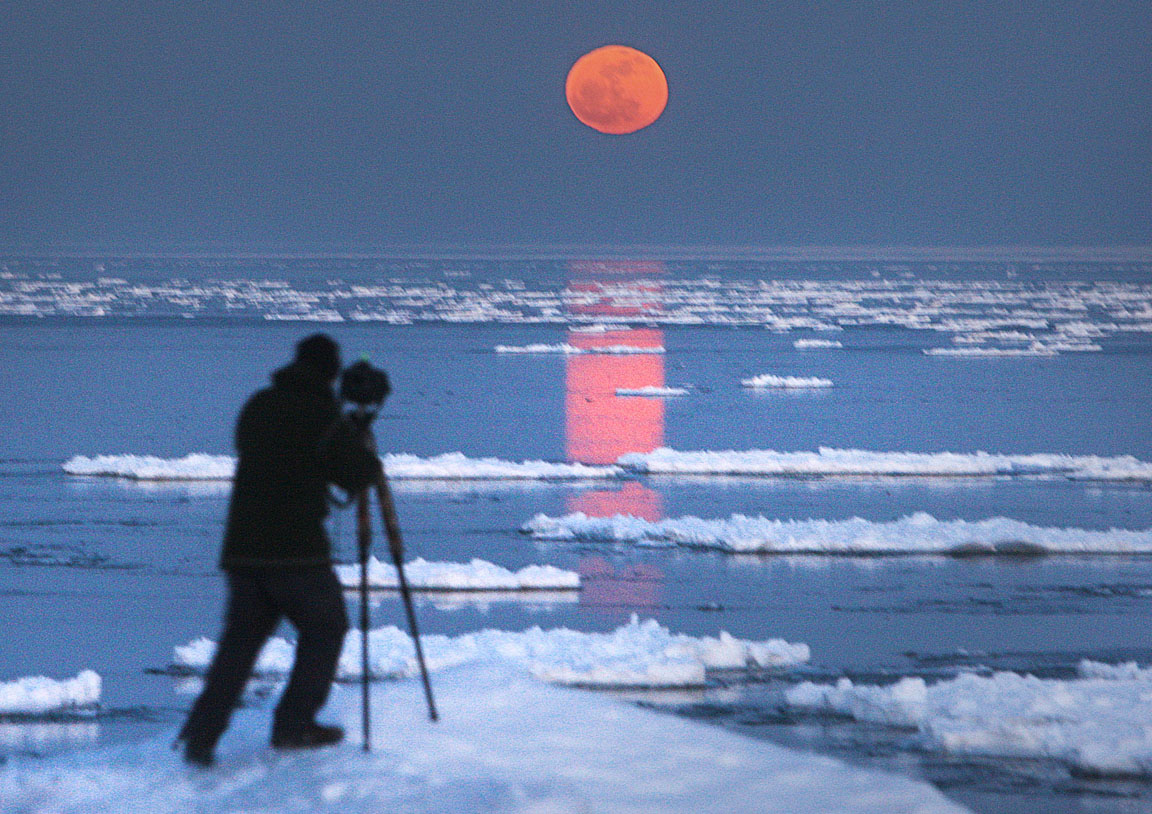
Depending on how low to the horizon you can see, it’s possible, especially over water, to catch the first glimpse of lunar limb breaching the horizon. This still can be a tricky feat because the Moon is pale, and when it rises, shows little contrast against the still-bright sky. Since the Moon moves about one outstretched fist to the east (left in the northern hemisphere) each night, if you wait until one night after full phase, the Moon will rise in a much darker sky and appear in more dramatic contrast against the sky background.
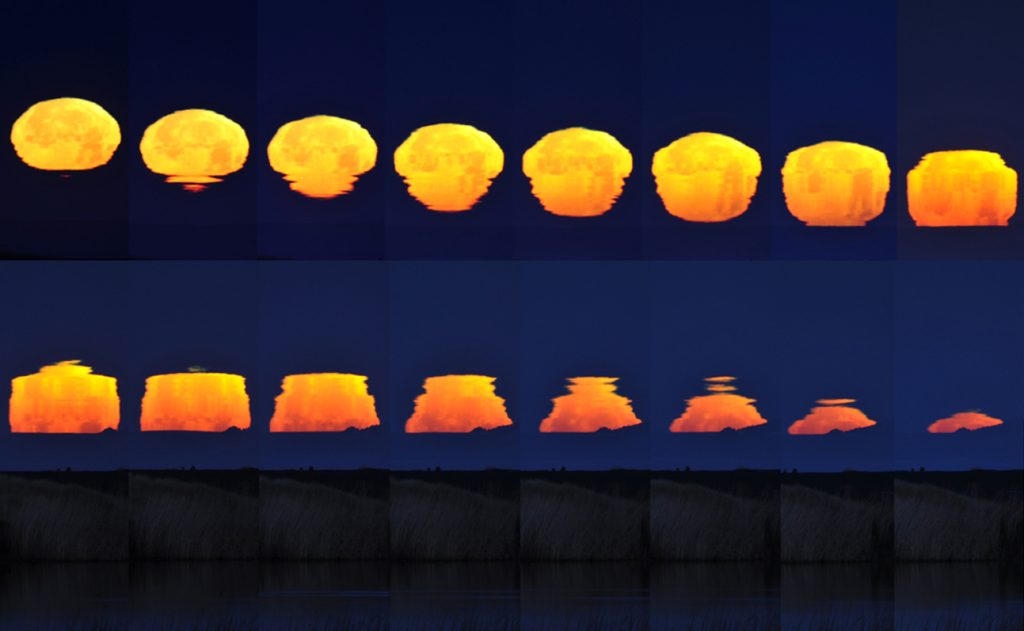
Look closely at the rising Moon with both naked eye and binoculars and you might just see a bit of atmospheric sorcery at work. Refraction, illustrated the icy moonrise image above, is the big one. It creates the squashed Moon shape. But more subtle things are happening that depend on how turbulent or calm the air is along your line of sight to our satellite.
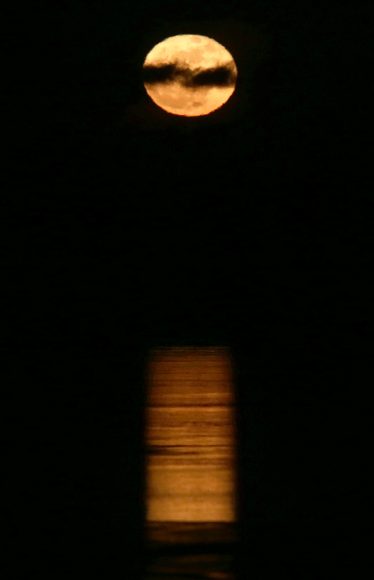
Rippling waves “sizzling” around the lunar circumference can be striking in binoculars though the effect is quite subtle with the naked eye. Much easier to see without any optical aid are the weird shapes the Moon can assume depending upon the state of the atmosphere. It can looked stretched out like a hot air balloon, choppy with a step-like outline around its bottom or top, square, split into two moons or even resemble a “mushroom cloud”.
If you make a point to watch moonrises regularly, you’ll become acquainted as much with Earth’s atmosphere as with the alien beauty of our sole satellite.
This Full Moon is special in at least two ways. First, it will undergo a penumbral eclipse for skywatchers across eastern Europe, Africa, Asia and Australia. Observers there should watch a dusky gray shading over the upper or northern half of the Moon around the time of maximum eclipse. The link will take you to Dave Dickinson’s excellent article that appeared earlier here at Universe Today.
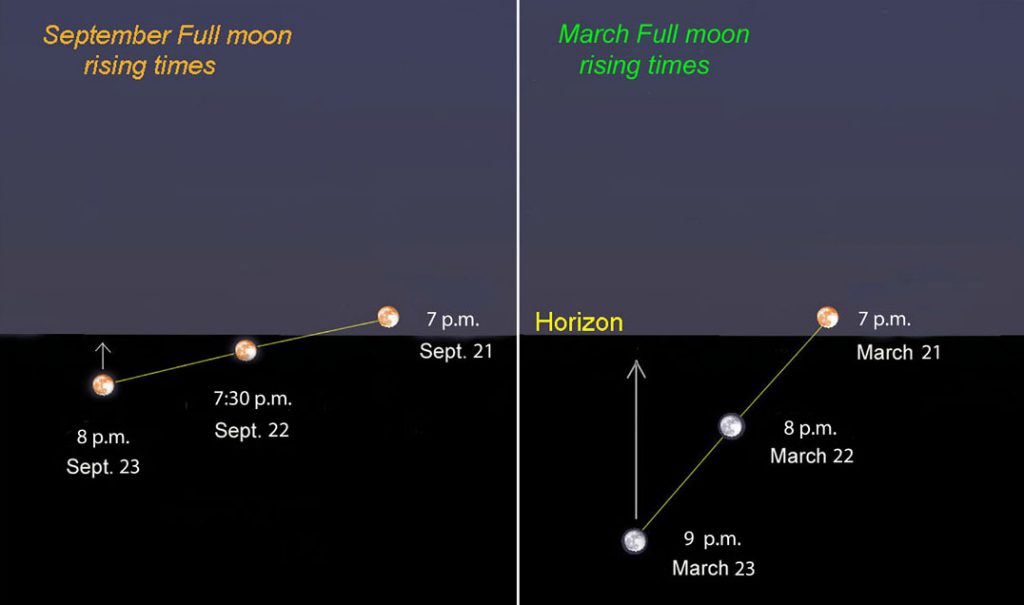
In the northern hemisphere, September’s Full Moon is named the Harvest Moon, defined as the Full Moon closest to the autumnal equinox, which occurs at 9:21 a.m. CDT (14:21 UT) on the 22nd. Normally, the Moon rises on average about 50 minutes later each night as it moves eastward along its orbit. But at Harvest Moon, successive moonrises are separated by a half-hour or less as viewed from mid-northern latitudes. The short gap of time between between bright risings gave farmers in the days before electricity extra light to harvest their crops, hence the name.
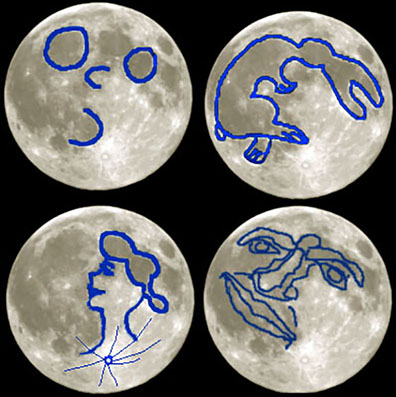
Why the faster-than-usual moonrises? Every September, the Full Moon’s nightly travels occur at a shallow angle to the horizon; as the moon scoots eastward, it’s also moving northward this time of year as shown in the illustration above. The northern and eastward motions combine to make the Moon’s path nearly level to the horizon. For several nights in a row, it only takes a half-hour for the Earth’s rotation to carry the Moon up from below the horizon. In spring, the angle is steep because the Moon is then moving quickly southward along or near the ecliptic, the path it takes around the sky. Rising times can exceed an hour.
As you gaze at the Moon over the next several nights, take in the contrast between its ancient crust, called the lunar highlands, and the darker seas (also known as maria, pronounced MAH-ree-uh). The crust appears white because it’s rich in calcium and aluminum, while the maria are slightly more recent basaltic lava flows rich in iron, which lends them a darker tone. Thanks to these two different types of terrain it’s easy to picture a male or female face or rabbit or anything your imagination desires.
Happy moongazing!
What is a Hunter’s Moon?
If you live in the northern hemisphere, than stargazing during the early autumn months can a bit tricky. During certain times in these seasons, the stars, planets and Milky Way will be obscured by the presence of some very beautiful full moons. But if you’re a fan of moongazing, then you’re in luck.
Because it is also around this time (the month of October) that people looking to the night sky will have the chance to see what is known as a Hunter’s Moon. A slight variation on a full moon, the Hunter’s Moon has long been regarded as a significant event in traditional folklore, and a subject of interest for astronomers.
Definition:
Also known as a sanguine or “blood” moon, the term “Hunters Moon” is used traditionally to refer to a full moon that appears during the month of October. It is preceded by the appearance of a “Harvest Moon”, which is the full moon closest to the autumnal equinox (which falls on the 22nd or 23rd of September).
The Hunter’s Moon typically appears in October, except once every four years when it doesn’t appear until November. The name dates back to the First Nations of North America. It is so-called because it was during the month of October, when the deers had fatted themselves over the course of the summer, that hunters tracked and killed prey by autumn moonlight, stockpiling food for the coming winter.
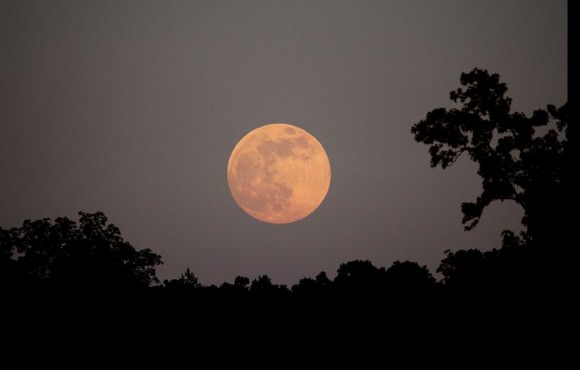
Characteristics:
Although typically the Moon rises 50 minutes later each day, things are different for the Hunter’s Moon (as well as the Harvest Moon). Both of these moons usually rise 30 minutes later on each successive night, which means that sunset and moonrise are not far apart.
This means there is prolonged periods of light during this time of the the year, which is the reason why these moons have traditionally been used by hunters and farmers to finish their work.
This difference between the timing of the sunset and moonrise is due to its orbit, meaning that the angle the Moon makes with the horizon is narrower during this time of year. The Hunter’s Moon is generally not bigger or brighter than any of the other full moons. Thus, the only difference between it and other full moons is the that the time between sunset and moonrise is shorter.
History of Observation:
Because the approach of winter signaled the possibility of going hungry in pre-Industrial times, the Hunter’s Moon was generally accorded with special honor, historically serving as an important feast day in both northern Europe and among many Native American tribes.
Traditionally, Native American hunters used the full moon of October to stalk deer and to spot foxes at night as they prepared for the coming winter. Because the fields were traditionally reaped in late September or early October, hunters could easily see foxes and other animals that came out to glean from the fallen grains.
The Hunter’s Moon is accorded similar significance in Europe, where it was also seen as a prime time to hunt during the post-harvest, pre-winter period when conditions were optimal for spotting prey. However, the term did not enter into usage for Europeans until after they made contact with Indigenous Americans and began colonizing North America.
The first recorded mentions of a “Hunter’s Moon” began in the early 18th century. The entry in the Oxford English Dictionary for “Hunter’s Moon” cites a 1710 edition of The British Apollo, where the term is attributed to “the country people”. The names are now referred to regularly by American sources, where they are often popularly attributed to “the Native Americans”.
In India, the harvest festival of Sharad Purnima, which marks the end of the monsoon season, is celebrated on the full moon day of the lunar month of Ashvin (September-October). There is a traditional celebration of the moon during this time that is known as the “Kaumudi” celebration – which translated, means “moonlight”.
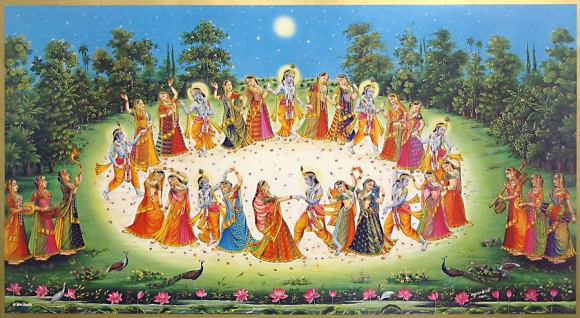
Interesting Facts:
Sometimes, the Harvest Moon is mistaken for the Hunter’s Moon because once every four years or so the Harvest Moon is in October instead of September. When that happens, the Hunter’s Moon is in November. Traditionally, each month’s full moon has been given a name, although these names differ according to the source.
Other full moons of interest include the Wolf Moon in January, the Strawberry Moon in June, the Sturgeon Moon in August, the Cold Moon in December, and the Pink Moon in April. All of the full moons have different characteristics due to the location of the ecliptic – i.e. the path of the Sun – at the time of each.
The Hunter’s Moon is also associated with feasting. In the Northern Hemisphere, some Native American tribes and some places in Western Europe held a feast day. This feast day, the Feast of the Hunter’s Moon, was not been held since the 1700’s. However, the Feast of the Hunters’ Moon is a yearly festival in Lafayette, Indiana, which has been held in late September or early October every year since 1968.
We have many interesting articles about the moon here at Universe Today. For example, here are some about the red moon and a rundown of what a full moon is all about.
For more information, check out the page on the Hunter’s Moon at NightSkyInfo, and full moon names and meanings, courtesy of the Farmer’s Almanac.
Astronomy Cast has an interesting episode on the subject – Episode 113: The Moon: Part I
Sources:
Guide to Tonight’s Big Harvest Moon
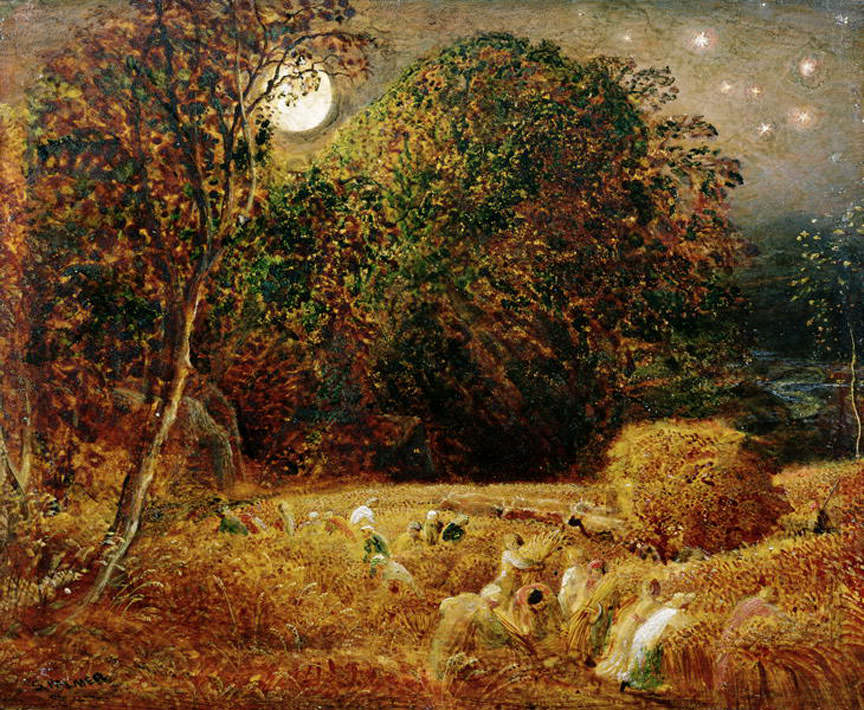
Tonight, September 8, the Harvest Moon rises the color of a fall leaf and spills its light across deserts, forests, oceans and cities. The next night it rises only a half hour later. And the next, too. The short gap of time between successive moonrises gave farmers in the days before electricity extra light to harvest their crops, hence the name.
The Harvest Moon is the full moon that falls closest to the autumnal equinox, the beginning of northern autumn. As the moon orbits the Earth, it moves eastward about one fist held at arm’s length each night and rises about 50 minutes later. You can see its orbital travels for yourself by comparing the moon’s nightly position to a bright star or constellation.
This full Moon is also a Proxigean or Perigee Full “Supermoon” (find out more about that here), which means the Moon is in a spot in its elliptical orbit where it is closer to Earth near the time it is full, making it look up to 15% larger than average full Moon.
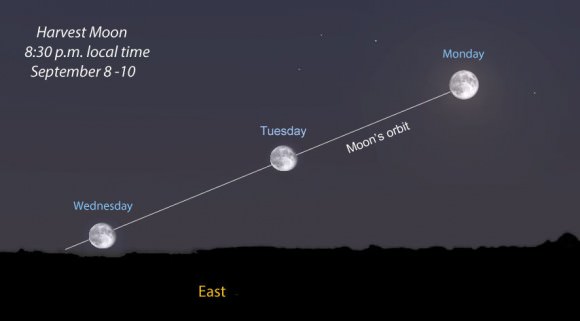
50 minutes is the usual gap between moonrises. But it can vary from 25 minutes to more than an hour depending upon the angle the moon’s path makes to the eastern horizon at rise time. In September that path runs above the horizon at a shallow angle. As the moon scoots eastward, it’s also moving northward this time of year.
This northward motion isn’t as obvious unless you watch the moon over the coming week. Then you’ll see it climb to the very top of its monthly path when it’s high overhead at dawn. The northward motion compensates for the eastward motion, keeping the September full moon’s path roughly parallel to the horizon with successive rise times only ~30 minutes apart.
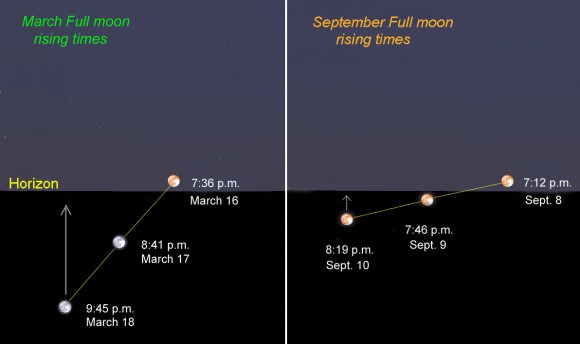
Exactly the opposite happened 6 months earlier this spring, when the moon’s path met the horizon at a steep angle. While it traveled the identical distance each night then as now, its tilted path dunked it much farther below the horizon night to night. The spring full moon moves east and south towards its lowest point in the sky. Seen from the northern hemisphere, that southward travel adds in extra time for the moon to reach the horizon and rise each successive night.
If all this is a bit mind-bending, don’t sweat it. Click HERE to find when the moon rises for your town and find a spot with a great view of the eastern horizon. You’ll notice the moon is orange or red at moonrise because the many miles of thicker atmosphere you look through when you gaze along the horizon scatters the shorter bluer colors from moonlight, tinting it red just as it does the sun.
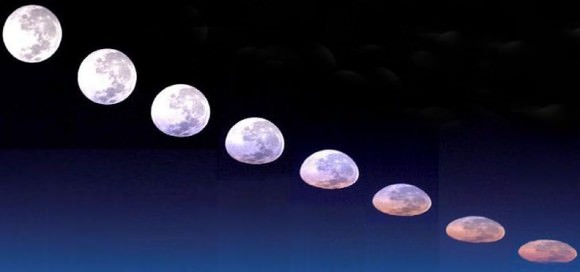
The moon will also appear squished due to atmospheric refraction. Air is densest right at the horizon and refracts or bends light more strongly than the air immediately above it. Air “lifts” the bottom of the moon – which is closer to the horizon – more than the top, squishing the two halves together into an egg or oval shape.
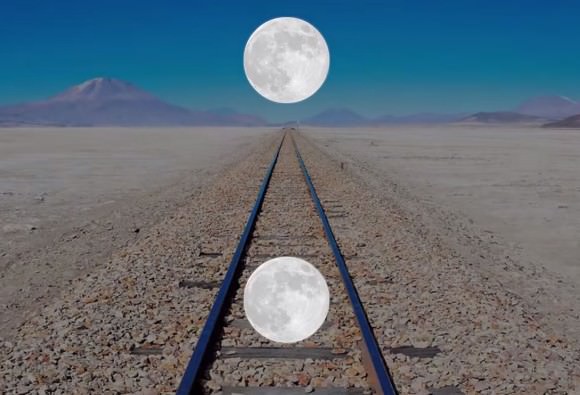
You may also be entranced Monday night by the Moon Illusion, where the full moon appears unnaturally large when near the horizon compared to when viewed higher up. No one has come up with a complete explanation for this intriguing aspect of our perception, but the link above offers some interesting hypotheses.
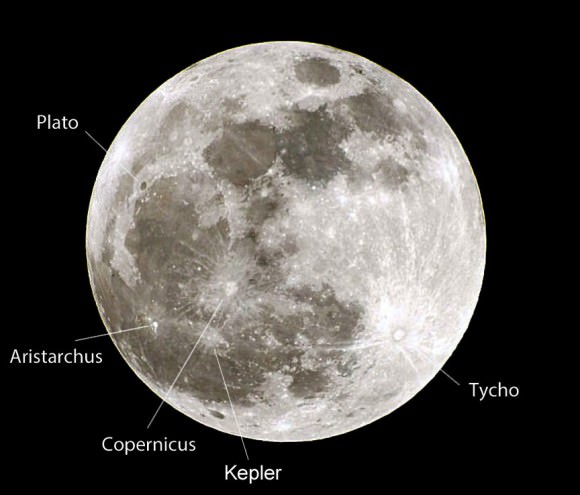
Finally, full moon is an ideal time to see several lunar craters with the naked eye. They’re not the biggest, but all, except Plato, are surrounded by bright rays of secondary impact craters that expand their size and provide good contrast against the darker lunar “seas”. Try with your eyes alone first, and if you have difficulty, use binoculars to get familiar with the landscape and then try again with your unaided eyes.
In contrast to the other craters, Plato is dark against a bright landscape. It’s a true challenge – I’ve tried for years but still haven’t convinced myself of seeing it. The others are easier than you’d think. Good luck and clear skies!
If you don’t have clear skies, Slooh will broadcast the “Super Harvest Moon” live from the Institute of Astrophysics of the Canary Islands, off the coast of Africa. Slooh’s live coverage will begin at 6:30 PM PDT / 9:30 PM EDT /01:30 UTC (8/9) – International times here. Slooh hosts are Geoff Fox and Slooh astronomer Bob Berman. Viewers can ask questions during the show by using hashtag #Sloohsupermoon. Watch below:
Get Set for the Super (or Do You Say Harvest?) Full Moon 3 of 3 for 2014
Time to dust off those ‘what is a perigee Full Moon’ explainer posts… the supermoon once again cometh this weekend to a sky near you.
Yes. One. More. Time.
We’ve written many, many times — as have many astronomy writers — about the meme that just won’t die. The supermoon really brings ‘em out, just like werewolves of yore… some will groan, some will bemoan the use of a modernized term inserted into the common astronomical vernacular that was wrought by an astrologer, while others will exclaim that this will indeed be the largest Full Moon EVER…
But hey, it’s a great chance to explain the weird and wonderful motion of our nearest natural neighbor in space. Thanks to the Moon, those astronomers of yore had some great lessons in celestial mechanics 101. Without the Moon, it would’ve been much tougher to unravel the rules of gravity that we take for granted when we fling a probe spaceward.
The Moon reaches Full on Tuesday, September 9th at 1:38 Universal Time (UT), which is 9:38 PM EDT on the evening of the 8th. The Moon reaches perigee at less than 24 hours prior on September 8th at 3:30 UT — 22 hours and 8 minutes earlier, to be precise — at a distance 358,387 kilometres distant. This is less than 2,000 kilometres from the closest perigee than can occur, and 1,491 kilometres farther away than last month’s closest perigee of the year, which occurred 27 minutes prior to Full Moon.
A Proxigean or Perigee Full “Supermoon” as reckoned by our preferred handy definition of “a Full Moon occurring within 24 hours of perigee” generally occurs annually in a cycle of three over two lunar synodic periods, and moves slowly forward by just shy of a month through the Gregorian calendar per year. The next cycle of “supermoons” starts on August 30th, 2015, and you can see our entire list of cycles out through 2020 here.
What’s the upshot of all this? Well, aside from cluttering inboxes and social media with tales of the impending supermoon this weekend, the rising Moon will appear 33.5’ arc minutes in diameter as opposed to its usually quoted average of 30’ in size. And remember, that’s in apparent size as seen from our Earthly vantage point… can you spy a difference from one Full Moon to the next? Fun fact: the rising Moon is actually farther away from you to the tune of about one Earth radius than when it’s directly overhead at the zenith.
Fed up with supermoon-mania? The September Full Moon also has a more pedestrian name: The Harvest Moon. Actually, this is the Full Moon that falls nearest to the September Equinox, marking the start of the astronomical season of Fall in the northern hemisphere and Spring in the southern. In the current first half of the 21st century, the September Equinox falls on the 22nd or 23rd, meaning that the closest Full Moon (and thus the Harvest Moon) can sometimes fall in October, as last happened in 2009 and will occur again in 2017. In this instance, the September Full Moon would then be referred to as the Corn Moon as reckoned by the Algonquins, and is occasionally referred to as the Drying Grass Moon by Sioux tribes. In 2014, the Harvest Full Moon “misses” falling in October by about 32 hours!
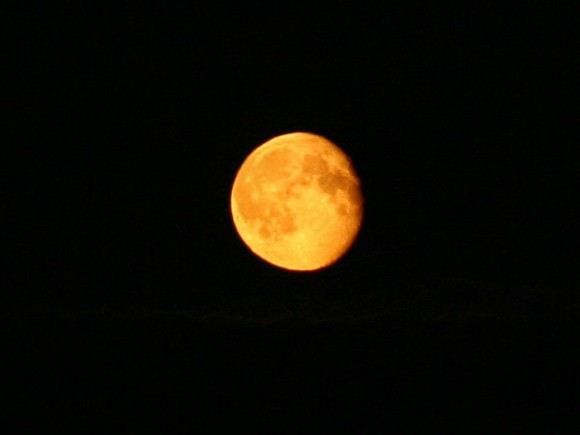
So, why is it known as the Harvest Moon? Well, in the age before artificial lighting (and artificial light pollution) the rising of the Full Moon as the Sun sets allowed for a few hours of extra illumination to bring in crops. In October, the same phenomenon gave hunters a few extra hours to track game by the light of the Full Hunters Moon, both essential survival activities before the onset of the long winter.
And that Full Harvest Moon seems to “stick around” on successive evenings. This is due to the relatively shallow angle of the evening ecliptic to the eastern horizon as seen from mid-northern latitudes in September.
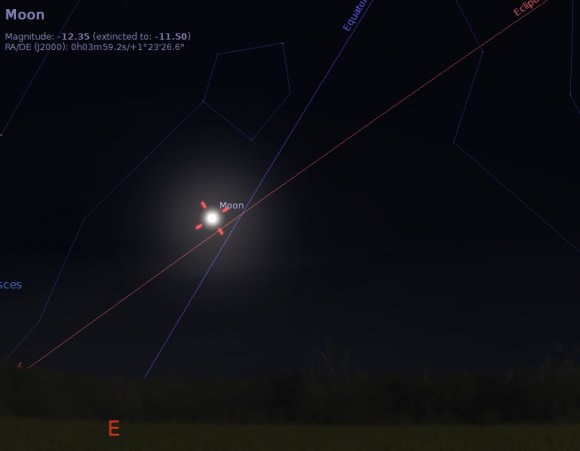
Here’s a sample of rising times for the Moon this month as seen from Baltimore, Maryland at 39.3 degrees north latitude:
Saturday, September 6th: 5:43 PM EDT
Sunday, September 7th: 6:23 PM EDT
Monday, September 8th: 7:05 PM EDT
Tuesday, September 9th: 7:44 PM EDT
Wednesday, September 10th: 8:22 PM EDT
Note the Moon rises only ~40 minutes later on each successive evening.
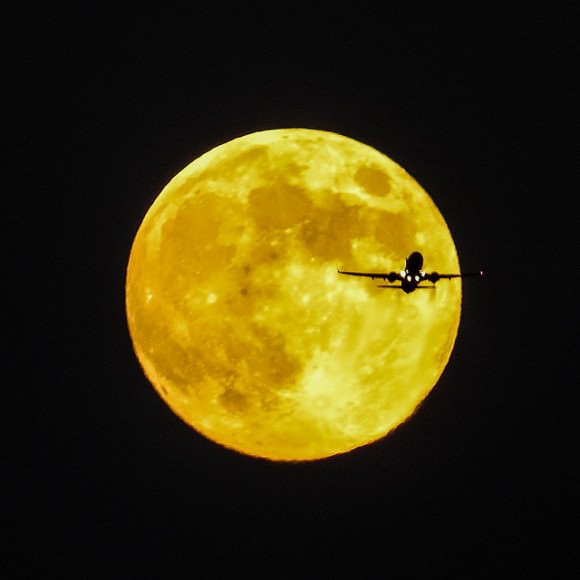
We’re also headed towards a “shallow year” in 2015, as the Moon bottoms out relative to the ecliptic and only ventures 18 degrees 20’ north and south of the celestial equator at shallow minimum. This is due to what’s known as the Precession of the Line of Apsides as the gravitational pull of the Sun slowly drags the orbit of the Moon round the earth once every 8.85 years. The nodes where the ecliptic and path of the Moon meet — and solar and lunar eclipses occur — also move slowly in an opposite direction of the Moon’s motion, taking just over twice as long as the Precession of the Line of Apsides to complete one revolution around the ecliptic at 18.6 years. This is one of the more bizarre facts about the motion of the Moon: its orbital tilt of 5.1 degrees is actually fixed with respect to the ecliptic as traced out by the Earth’s orbit about the Sun, not our rotational axis. Native American and ancient Northern European knew of this, and the next “Long Night’s Moon” also called a “Lunar Standstill” when the Moon rides high in the northern hemisphere sky is due through 2024-2025.
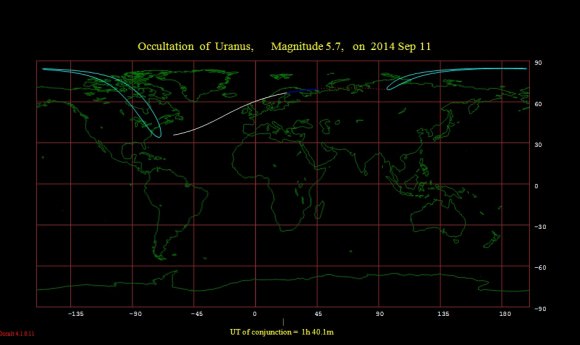
And to top it off, the Moon occults Uranus just two days after Full on September 11th as seen from northeastern North America, Greenland, Iceland and northern Scandinavia. We’re in a cycle of occultations of Uranus by the Moon from late 2014 through 2015, and this will set the ice giant up for a spectacular close pass, and a rare occultation of the planet for a remote region in the Arctic during the October 8th total lunar eclipse…
More to come!
Tonight’s Harvest Moon Is For The Birds … Really!
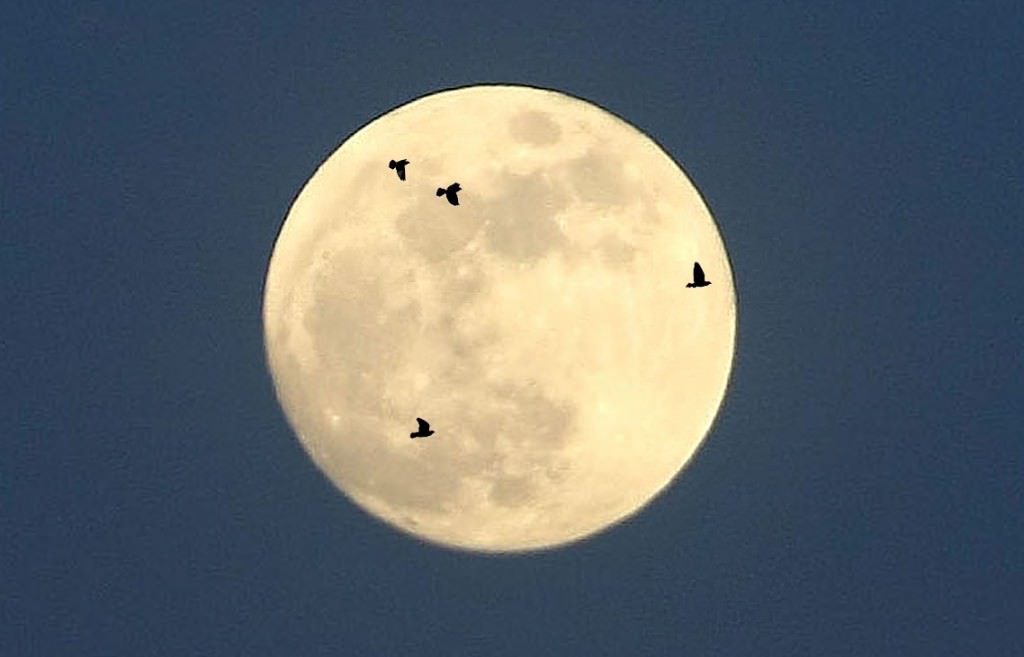
Tonight’s the Harvest Moon, the full Moon closest to the fall equinox. A perfect time to catch a big orange Moon on the horizon AND the annual fall bird migration. Every September and October anyone with a small telescope or spotting scope magnifying 30x can enjoy the sight of one bird after another flying over the cratered lunar landscape. It’s so easy.
Point your telescope at the Moon and watch for dark silhouettes to flutter across its face. Because the angle of the full Moon’s path to the horizon is very shallow in September and October, the time difference between successive moonrises is only about 20-30 minutes instead of the usual 50-60. That means you’ll catch both moonlight and bird flight on successive nights without having to stay up late.
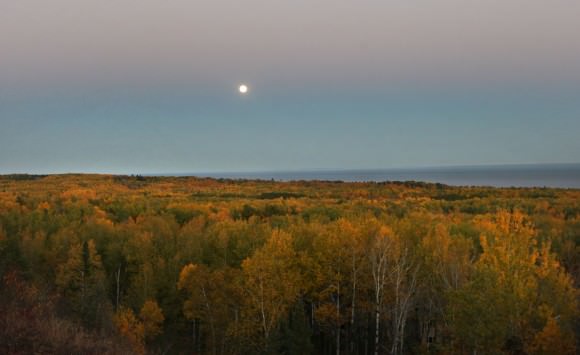
Many birds migrate at night both because it’s cooler and to avoid predators that could otherwise pick them off in a daylight run. Identifying the many warblers, blackbirds, sparrows, vireos, orioles and other species that fly across the moon while we sleep may be next to impossible for anyone but an expert, but seeing them is easy. Two night ago for fun, I counted a dozen birds in the five-minute interval around 10 o’clock through my 10-inch telescope at low power (76x). Assuming they continued to fly by at a steady rate, I could potentially have spotted 144 birds in just an hour’s time.

As you might suspect, most of those birds crossed the Moon from north to south (about two-thirds) with the other third traveling either east to west or northeast to southwest. Only one little silhouette flapped back up north in the ‘wrong’ direction.
According to the Chipper Woods Bird Observatory, located in Indianapolis, most nighttime migrators begin their flight right after sunset and continue until about 2 a.m. Peak time is between 11 p.m. and 1 a.m. Bird typically migrate at altitudes ranging from 1,500 to 5,000 feet, but on some nights, altitudes may range from 6,000 and 9,000 feet. I could tell the high ones from the low ones by their size and sharpness. Nearby birds flew by out of focus, while distant ones were sharply defined and took longer to cross the moon.

While birders may continue to use the moon night birding, they now have a new tool – NEXRAD or NEXt-generation of Weather RADar. About 150 NEXRAD sites were set up in the 1990s to track weather and storm systems across the U.S. When precipitation gets pinged by the radar’s pulse it reflects back a signal that identifies it as rain, snow or whatever. Included in the information is the material’s speed and direction of travel. NEXRAD works equally well on meteorite falls, birds and even insects. While storm activity typically shows up as familiar blotches of yellow, orange and red, birds appear as fine stipplings. By compiling NEXRAD loops, during particularly heavy migration times, you can actually watch swarms of birds wing their way south. Click HERE for a map of all U.S. NEXRAD locations, each of which links to current radar maps.
On the less technological side, watching birds pass across the Moon in a small telescope is a very pleasant activity reminiscent of meteor shower watching. At first you see nothing, then blip! a bird (meteor) flies by. You wait another minute and then suddenly two more appear in tandem. Both activities give you that delicious sense of anticipation of what the next moment might hold.
The best time to watch the nighttime avian exodus is around full Moon, when the big, round disk offers an ideal spotlight on the birds’ behavior, but anytime between waxing and waning gibbous phase will work. It’s an enchanting sight to see Earth’s creatures streak across an alien landscape, and another instance of how a distant celestial body “touches” Earth in unexpected ways.
The September Equinox: ‘Tis the Season to Spy the Zodiacal Light
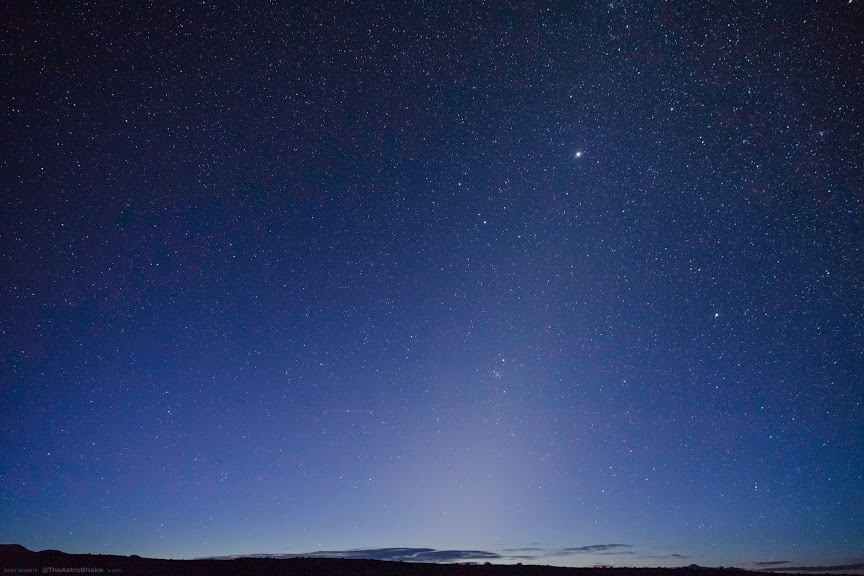
This week leading up to the September equinox offers you a fine chance to catch an elusive phenomenon in the pre-dawn sky.
We’re talking about the zodiacal light, the ghostly pyramid-shaped luminescence that heralds the approach of dawn. Zodiacal light can also be seen in the post-dusk sky, extending from the western horizon along the ecliptic.
September is a great time for northern hemisphere observers to try and sight this glow in the early dawn. This is because the ecliptic is currently at a high and favorable angle, pitching the zodiacal band out of the atmospheric murk low to the horizon. For southern hemisphere observers, September provides the best time to hunt for the zodiacal light after dusk. In March, the situation is reversed, with dusk being the best for northern hemisphere observers and dawn providing the best opportunity to catch this elusive phenomenon for southern observers.
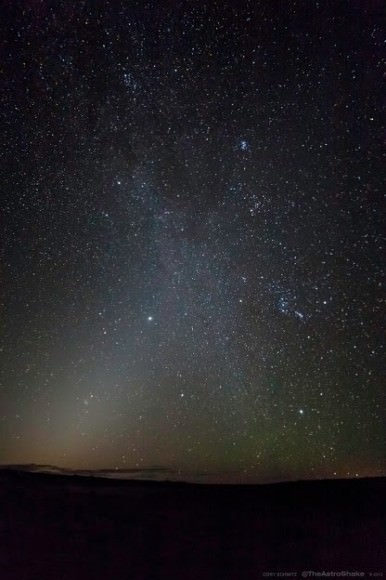
Cory Schmitz’s recent outstanding photos taken from the Nevada desert brought to mind just how ephemeral a glimpse of the zodiacal light can be. The glow was a frequent sight for us from dark sky sites just outside of Tucson, Arizona—but a rarity now that we reside on the light-polluted east coast of the U.S.
In order to see the zodiacal light, you’ll need to start watching before astronomical twilight—the start of which is defined as when the rising Sun reaches 18 degrees below the local horizon—and observe from as dark a site as possible under a moonless sky.
The Bortle dark sky scale lists the zodiacal light as glimpse-able under Class 4 suburban-to-rural transition skies. Under a Class 3 rural sky, the zodiacal light may extend up to 60 degrees above the horizon, and under truly dark—and these days, almost mythical—Class 1 and 2 skies, the true nature of the zodiacal band extending across the ecliptic can become apparent. The appearance and extent of the zodiacal light makes a great gauge of the sky conditions at that favorite secret dark sky site.
The source of the zodiacal light is tiny dust particles about 10 to 300 micrometres in size scattered across the plane of the solar system. The source of the material has long been debated, with the usual suspects cited as micrometeoroid collisions and cometary dust. A 2010 paper by Peter Jenniskens and David Nesvorny in the Astrophysical Journal cites the fragmentation of Jupiter-class comets. Their model satisfactorily explains the source of about 85% of the material. Dust in the zodiacal cloud must be periodically replenished, as the material is slowly spiraling inward via what is known as the Poynting-Robertson effect. None other than Brian May of the rock group Queen wrote his PhD thesis on Radial Velocities in the Zodiacal Dust Cloud.
But even if you can’t see the zodiacal light, you still just might be able to catch it. Photographing the zodiacal light is similar to catching the band of the Milky Way. In fact, you can see the two crossing paths in Cory’s images, as the bright winter lanes of the Orion Spur are visible piercing the constellation of the same name. Cory used a 14mm lens at f/3.2 for the darker image with a 20 second exposure at ISO 6400 and a 24mm lens at f/2.8 with a 15 second exposure at ISO 3200 for the brighter shot.
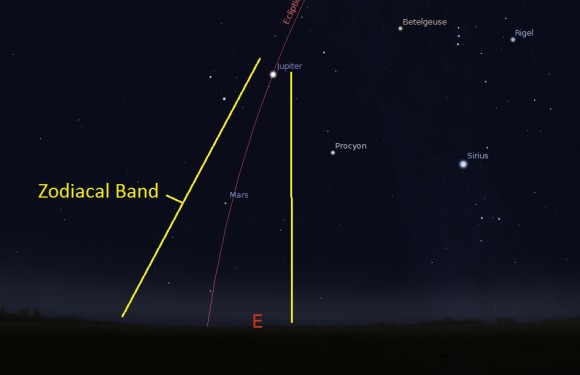
Under a truly dark site, the zodiacal light can compete with the Milky Way in brightness. The early Arab astronomers referred to it as the false dawn. In recent times, we’ve heard tales of urbanites mistaking the Milky Way for the glow of a fire on the horizon during blackouts, and we wouldn’t be surprised if the zodiacal light could evoke the same. We’ve often heard our friends who’ve deployed to Afghanistan remark how truly dark the skies are there, as military bases must often operate with night vision goggles in total darkness to avoid drawing sniper fire.
Another even tougher but related phenomenon to spot is known as the gegenschein. This counter glow sits at the anti-sunward point where said particles are approaching 100% illumination. This time of year, this point lies off in the constellation Pisces, well away from the star-cluttered galactic plane. OK, we’ve never seen it, either. A quick search of the web reveals more blurry pics of guys in ape suits purporting to be Bigfoot than good pictures of the gegenschein. Spotting this elusive glow is the hallmark of truly dark skies. The anti-sunward point and the gegenschein rides highest near local midnight.
And speaking of which, the September equinox occurs this weekend on the 22nd at 4:44 PM EDT/20:44 Universal Time. This marks the beginning of Fall for the northern hemisphere and the start of summer for the southern.
The Full Harvest Moon also occurs later this week, being the closest Full Moon to the equinox occurring on September 19th at 7:13AM EDT/11:13 UT. Said Moon will rise only ~30 minutes apart on successive evenings for mid-northern latitude observers, owing to the shallow angle of the ecliptic. Unfortunately, the Moon will then move into the morning sky, drowning out those attempts to spy the zodiacal light until late September.
Be sure to get out there on these coming mornings and check out the zodiacal light, and send in those pics in to Universe Today!
Huge Asteroid 324 Bamberga Makes a Return Visit to Earth’s Neighborhood on Friday the 13th
This week offers a fine chance to catch sight of a unique asteroid.
324 Bamberga reaches opposition this week in the constellation Pisces on (friggatriskaidekaphobics take note) Friday the 13th at 7AM EDT/11:00 Universal Time.
About 230 kilometres in size, 324 Bamberga reaches 0.81 astronomical units from the Earth this week. No other asteroid so large gets so close.
Discovered on February 25th, 1892 by Johann Palisa, 324 Bamberga only reaches a favorable opposition once every 22 years.
Shining at magnitude +8.1, 324 Bamberga is also one of the highest numbered asteroids visible with binoculars. Earth-crossing asteroids 433 Eros, which made a close pass last year, and 4179 Toutatis are two of the very few asteroids that possess a larger number designations that can regularly reach +10th magnitude.
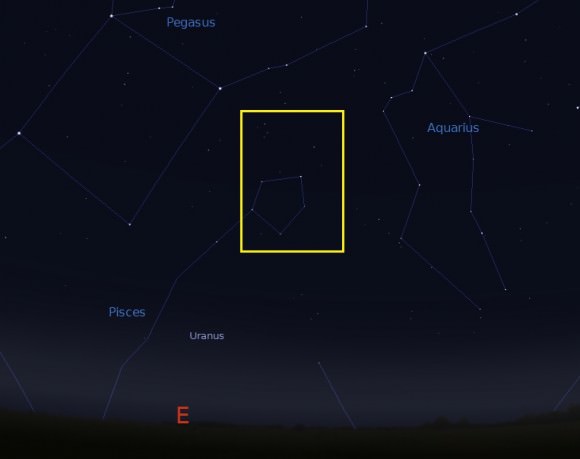
So, why did it take so long for 324 Bamberga to be uncovered? One factor is its high orbital eccentricity of 0.34. This means that most of the oppositions of the asteroid aren’t favorable. 324 Bamberga orbits the Sun once every 4.395 years and only comes around to an opposition that lands near perihelion once every 22 Earth years. Perihelion this year occurs only 45 days after opposition on October 27th.
The resonance between 324 Bamberga and Earth is nearly five Earth orbits for every one circuit of the Sun for the asteroid and is offset by only 9 days, meaning that the 22 year window to see the asteroid will actually become less favorable in centuries to come. 324 Bamberga made its last favorable appearance on September 15th, 1991 and won’t surpass +10th magnitude again until September 2035.
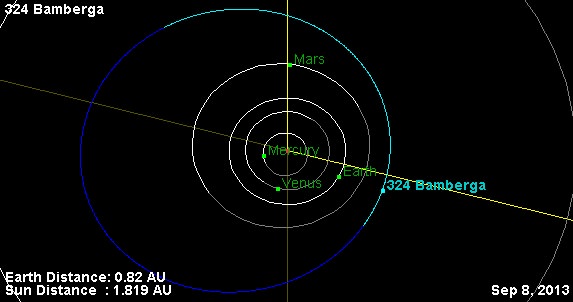
Observing asteroids requires patience and the ability to pick out a slowly moving object amidst the starry background. 324 Bamberga spends September west of the circlet of Pisces, drifting two degrees a week, or just over 17’ a day, to cross over into the constellation Pegasus in early October.
324 Bamberga will be moving too slow to pick up any motion in real time, but you can spy it by either sketching the field on successive nights or photographing the region and noting if the asteroid can be seen changing position against the background of fixed stars. Start hunting for 324 Bamberga tonight, as the Full Harvest Moon will be visiting Pisces later next week on the 19th.
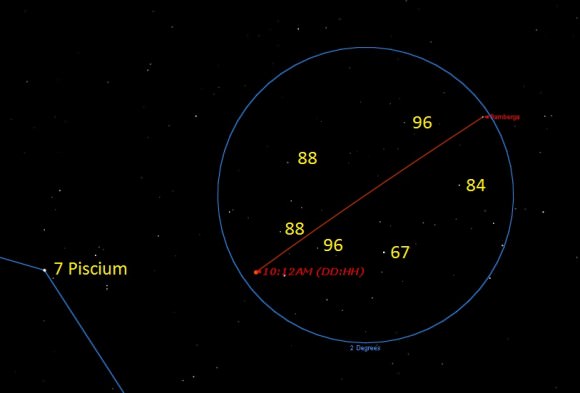
324 Bamberga is also unique as the brightest C-type asteroid that is ever visible from Earth. The runner up in this category is asteroid 10 Hygiea, which can shine a full magnitude fainter at opposition.
It’s also remarkable that Palisa actually managed to discover 324 Bamberga while it was at 12th magnitude! Palisa was one of the most prolific visual hunters of asteroids ever, discovering 121 asteroids from 1874 to 1923. He accomplished this feat first with the use of a 6” refractor while based at the Austrian Naval Observatory in Pola (now the Croatian town of Pula) and later using the Vienna observatory’s 27” inch refractor.
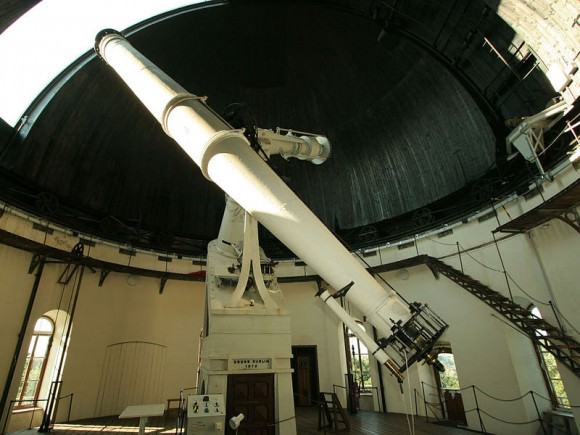
324 Bamberga itself takes its name from the town of Bamberg in Bavaria, the site of the 1896 meeting of the Astronomische Gesellschraft.
An occultation of a star by 324 Bamberga on December 8th, 1987 allowed astronomers to pin down its approximate size. Searches have also been carried out during occultations for any possible moons of this asteroid, though thus far, none have been discovered.
It’s interesting to note that 324 Bamberga will also actually occult the star 2UCAC 3361042 tonight in the early morning hours at 8:59-9:10 UT for observers spanning a path from Florida to Oregon. The magnitude drop will, however, be very slight, as the star is actually 3 full magnitudes fainter than the asteroid itself. Dave Gee caught a fine occultation of a 7.4 magnitude star in the constellation Corvus by 324 Bamberga in 2007.
There’s also something special about this time of year and the region that 324 Bamberga is crossing. More visual discoveries of asteroids have been historically made in the month of September than any other calendar month. In fact, 344 of the first 1,940 numbered asteroids were found in September, more than twice the average. Palisa’s own track record bears this out, though 324 Bamberga was discovered in February.
One of the primary reasons for a September surge in discoveries is viewing direction. Astronomers of yore typically hunted for asteroids approaching opposition in the anti-sunward direction, which in September lies in the relatively star poor fields of Pisces. In December and June —the months with the lowest numbers of visual discoveries at only 75 and 65 for the “first 1,940” respectively —the anti-sunward point lies in the star-rich regions of Sagittarius and Gemini. And by the way, the meteor that exploded over the city of Chelyabinsk on February 15th was sneaking up on the Earth from the sunward direction.
Be sure to catch a glimpse of this unique asteroid through either binoculars or a telescope over the coming weeks. The next chance to observe 324 Bamberga won’t roll around again until September 2035… it’ll be great to compare notes of the 2013 apparition on that far off date!
Weekly SkyWatcher’s Forecast: September 24-30, 2012
“Shine on, shine on Harvest Moon… Up in the sky…” Oh! Howdy, fellow SkyWatchers! The seasons are most surely showing their changes in both hemispheres and this week marks the famous “Harvest Moon”. The Moon will very much be in the eyepiece this week, so enjoy some great studies. However, don’t put away your telescopes just yet! Bright skies are a great time to catch up on double star studies and variables. Whenever you’re ready, just meet me in the back yard…
Monday, September 24 – In 1970, the first unmanned, automated return of lunar material to the Earth occurred on this day when the Soviet’s Luna 16 returned with three ounces of the Moon. Its landing site was eastern Mare Fecunditatis. Look just west of the bright patch of Langrenus. Let’s walk upon the Moon this evening as we take a look at sunrise over one of the most often studied and mysterious of all craters – Plato. Located on the northern edge of Mare Imbrium and spanning 95 kilometers in diameter, Class IV Plato is simply a feature that all lunar observers check because of the many reports of unusual happenings. Over the years, mists, flashes of light, areas of brightness and darkness, and the appearance of small craters have become a part of Plato’s lore.
On October 9, 1945 an observer sketched and reported “a minute, but brilliant flash of light” inside the western rim. Lunar Orbiter 4 photos later showed where a new impact may have occurred. While Plato’s interior craterlets average between less than one and up to slightly more than two kilometers in diameter, many times they can be observed – and sometimes they cannot be seen at all under almost identical lighting conditions. No matter how many times you observe this crater, it is ever changing and very worthy of your attention!
Although tonight’s bright skies will make our next target a little difficult to find visually, look around four fingerwidths southwest of Delta Capricorni (RA 21 26 40 Dec -22 24 40) for Zeta. Also known as 34 Capricorni, Zeta is a unique binary system. Located about 398 light-years from Earth, the primary star is a yellow supergiant with some very unusual properties – it’s the warmest, most luminous barium star known. But that’s not all, because the B component is a white dwarf almost identical in size to our own Sun!
Tuesday, September 25 – Tonight would be a great opportunity to take another look at crater Eratosthenes. Just slightly north of lunar center, this easily spotted feature dangles at the end of the Apennine Mountain range like a yo-yo caught on a string. Its rugged walls and central peaks make for excellent viewing. If you look closely at the mountains northeast of Eratosthenes, you will see the high peak of Mons Wolff. Named for the Dutch philosopher and mathematician, this outstanding feature reaches 35 kilometers in height. To the southwest of Era-tosthenes you may also spot the ruined remains of crater Stadius. Very little is left of its walls and the floor is dotted with small strikes. Near the twin pair of punctuations to its south lie the remains of Surveyor 2! Now let’s journey to a very pretty star field as we head toward the western wing tip in Cygnus to have a look at Theta – also known as 13 Cygni. It is a beautiful main sequence star that is also considered by modern catalogs to be a double. For large telescopes, look for a faint (13th magnitude) companion to the west… But it’s also a wonderful optical triple!
Also in the field with Theta to the southeast is the Mira-type variable R Cygni, which ranges in magnitude from around 7 to 14 in slightly less than 430 days. This pulsating red star has a really quite interesting history that can be found at AAVSO, and is circumpolar for far northern observers. Check it out!
Wednesday, September 26 – Tonight on the Moon, let’s take an in-depth look at one of the most impressive of the southern lunar features – Clavius.
Although you cannot help but be drawn visually to this crater, let’s start at the southern limb near the terminator and work our way up. Your first sighting will be the large and shallow dual rings of Casatus with its central crater and Klaproth adjoining it. Further north is Blancanus with its series of very small interior craters, but wait until you see Clavius. Caught on the southeast wall is Rutherford with its central peak and crater Porter on the northeast wall. Look between them for the deep depression labeled D. West of D you will also see three outstanding impacts: C, N and J; while CB resides between D and Porter. The southern and southwest walls are also home to many impacts, and look carefully at the floor for many, many more! It has been often used as a test of a telescope’s resolving power to see just how many more craters you can find inside tremendous old Clavius. Power up and enjoy!
And if you’d like to visit an object that only requires eyes, then look no further than Eta Aquilae one fist-width due south of Altair…
Discovered by Pigot in 1784, this Cepheid-class variable has a precision rate of change of over a magnitude in a period of 7.17644 days. During this time it will reach of maximum of magnitude 3.7 and decline slowly over 5 days to a minimum of 4.5… Yet it only takes two days to brighten again! This period of expansion and contraction makes Eta very unique. To help gauge these changes, compare Eta to Beta on Altair’s same southeast side. When Eta is at maximum, they will be about equal in brightness.
Thursday, September 27 – Tonight exploring the Moon will be in order as one of the most graceful and recognizable lunar features will be prominent – Gassendi. As an ancient mountain-walled plain that sits proudly at the northern edge of Mare Humorum, Gassendi sports a bright ring and a triple central mountain peak that are within the range of binoculars.
Telescopic viewers will appreciate Gassendi at high power in order to see how its southern border has been eroded by lava flow. Also of note are the many rilles and ridges that exist inside the crater and the presence of the younger Gassendi A on the north wall. While viewing the Mare Humorum area, keep in mind that we are looking at an area about the size of the state of Arkansas. It is believed that a planetoid collision originally formed Mare Humorum. The incredible impact crushed the surface layers of the Moon resulting in a concentric “anticline” that can be traced out to twice the size of the original impact area. The floor of this huge crater then filled in with lava, and was once thought to have a greenish appearance but in recent years has more accurately been described as reddish. That’s one mighty big crater!
Tonight we’ll begin with an easy double star and make our way towards a more difficult one. Beautiful, bright and colorful, Beta Cygni is an excellent example of an easily split double star. As the second brightest star in the constellation of Cygnus, Albireo lies roughly in the center of the “Summer Triangle” making it a relatively simple target for even urban telescopes.
Albireo’s primary (or brightest) star is around magnitude 4 and has a striking orangish color. Its secondary (or B) star is slightly fainter at a bit less than magnitude 5, and often appears to most as blue, almost violet. The pair’s wide separation of 34? makes Beta Cygni an easy split for all telescopes at modest power, and even for larger binoculars. At approximately 410 light-years away, this colorful pair shows a visual separation of about 4400 AU, or around 660 billion kilometers. As Burnham noted, “It is worth contemplating, in any case, the fact that at least 55 solar systems could be lined up, edge-to-edge, across the space that separates the components of this famous double!”
Now let’s have a look at Delta. Located around 270 light-years away, Delta is known to be a more difficult binary star. Its duplicity was discovered by F. Struve in 1830, and it is a very tough test for smaller optics. Located no more than 220 AU away from the magnitude 3 parent star, the companion orbits anywhere from 300 to 540 years and is often rated as dim as 8th magnitude. If skies aren’t steady enough to split it tonight, try again! Both Beta and Delta are on many challenge lists.
Friday, September 28 – Tonight our primary lunar study is crater Kepler. Look for it as a bright point, slightly lunar north of center near the terminator. Its home is the Oceanus Procellarum – a sprawling dark mare composed primarily of dark minerals of low reflectivity (albedo) such as iron and magnesium. Bright, young Kepler will display a wonderfully developed ray system. The crater rim is very bright, consisting mostly of a pale rock called anorthosite. The “lines” extending from Kepler are fragments that were splashed out and flung across the lunar surface when the impact occurred. The region is also home to features known as “domes” – seen between the crater and the Carpathian Mountains. So unique is Kepler’s geological formation that it became the first crater mapped by U.S. Geological Survey in 1962.
Up next, we’ll have a look at the central star of the “Northern Cross” – Gamma Cygni. Also known as Sadr, this beautiful main sequence star lies at the northern edge of the “Great Rift.” Surrounded by a field of nebulosity known as IC 1310, second magnitude Gamma is very slowly approaching us, but still maintains an average distance of about 750 light-years. It is here in the rich, starry fields that the great dust cloud begins its stretch toward southern Centaurus – dividing the Milky Way into two streams. The dark region extending north of Gamma towards Deneb is often referred to as the “Northern Coalsack,” but its true designation is Lynds 906.
If you take a very close look at Sadr, you will find it has a well-separated 10th magnitude companion star, which is probably not related – yet in 1876, S. W. Burnham found that it itself is a very close double. Just to its north is NGC 6910 (Right Ascension: 20 : 23.1 – Declination: +40 : 47), a roughly 6th magnitude open cluster which displays a nice concentration in a small telescope. To the west is Collinder 419, another bright gathering that is nicely concentrated. South is Dolidze 43, a widely spaced group with two brighter stars on its southern perimeter. East is Dolidze 10, which is far richer in stars of various magnitudes and contains at least three binary systems.
Whether you use binoculars or telescopes, chances are you won’t see much nebulosity in this region – but the sheer population of stars and objects in this area makes a visit with Sadr worthy of your time!
Saturday, September 29 – Tonight we’re going to have a look at a lunar feature that goes beyond simply incredible – it’s downright weird. Start your journey by identifying Kepler and head due west across Oceanus Procellarum until you encounter the bright ring of crater Reiner. Spanning 30 kilometers, this crater isn’t anything in particular – just shallow-looking walls with a little hummock in the center. But, look further west and a little more north for an anomaly – Reiner Gamma.
Well, it’s bright. It’s slightly eye-shaped. But what exactly is it? Possessing no real elevation or depth above the lunar surface, Reiner Gamma could very well be an extremely young feature caused by a comet. Only three other such features exist – two on the lunar far side and one on Mercury. They are high albedo surface deposits with magnetic properties. Unlike a lunar ray of material ejected from below the surface, Reiner Gamma can be spotted during the daylight hours – when ray systems disappear. And, unlike other lunar formations, it never casts a shadow.
Reiner Gamma also causes a magnetic deviation on a barren world that has no magnetic field. This has many proposed origins, such as solar storms, volcanic gaseous activity, or even seismic waves. But, one of the best explanations for its presence is a cometary strike. It is believed that a split-nucleus comet, or cometary fragments, once impacted the area and the swirl of gases from the high velocity debris may have somehow changed the regolith. On the other hand, ejecta from an impact could have formed around a magnetic “hot spot,” much like a magnet attracts iron filings. No matter which theory is correct, the simple act of viewing Reiner Gamma and realizing that it is different from all other features on the Moon’s earthward facing side makes this journey worth the time!
When you’re done, let’s head about a fingerwidth south of Gamma Cygni to have a look at an open cluster well suited for all optics – M29 (Right Ascension: 20 : 23.9 – Declination: +38 : 3).
Discovered in 1764 by Charles Messier, this type D cluster has an overall brightness of about magnitude 7, but isn’t exactly rich in stars. Hanging out anywhere from 6000 to 7200 light-years away, one would assume this to be a very rich cluster and it may very well have hundreds of stars – but their light is blocked by a dust cloud a thousand times more dense than average. Approaching us at around 28 kilometers per second, this loose grouping could be as old as 10 million years and appears much like a miniature of the constellation of Ursa Major at low powers. Even though it isn’t the most spectacular in star-rich Cygnus, it is another Messier object to add to your list!
Sunday, September 30 – Today in 1880, Henry Draper must have been up very early indeed when he took the first photo of the Great Orion Nebula (M42). Although you might not wish to set up equipment before dawn, you can still use a pair of binoculars to view this awesome nebula! You’ll find Orion high in the southeast for the Northern Hemisphere, and M42 in the center of the “sword” that hangs below its bright “belt” of three stars.
Our seasons are changing – and so the seasons change on other planets, too. Today marks the universal date on which Northern Autumn, Southern Spring Equinox occurs on Mars. Keep an eye for subtle changes in surface features of the red planet!
This is also the Universal date the Moon will become Full and it will be the closest to the Autumnal Equinox. Because its orbit is more nearly parallel to the eastern horizon, it will rise at dusk for the next several nights in a row. On the average, the Moon rises about 50 minutes later each night, but at this time of year it’s around 20 minutes later for mid-northern latitudes and even less farther north. Because of this added light, the name “Harvest Moon” came about because it allowed farmers more time to work in the fields.
Often times we perceive the Harvest Moon as being more orange than at any other time of the year. The reason is not only scientific enough – but true. Coloration is caused by the scattering of the light by particles in our atmosphere. When the Moon is low, like now, we get more of that scattering effect and it truly does appear more orange. The very act of harvesting itself produces more dust and often times that coloration will last the whole night through. And we all know the size is only an “illusion”…
So, instead of cursing the Moon for hiding the deep sky gems tonight, enjoy it for what it is…a wonderful natural phenomenon that doesn’t even require a telescope!
Until next week? Ask for the Moon, but keep on reaching for the stars!


